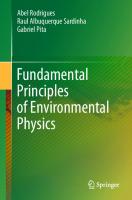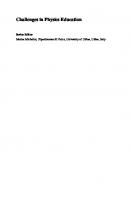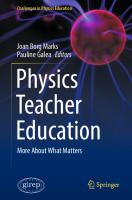Fundamental Physics and Physics Education Research 3030529223, 9783030529222
This book highlights selected contributions presented at the 15th annual international symposium Frontiers of Fundamenta
345 56 8MB
English Pages 290 [289] Year 2020
Table of contents :
Preface
International Frontiers of Fundamental Physics Symposium Series
(Fifteenth in the Series, Orihuela)
Contents
Part I: Fundamental Physics
Chapter 1: Symmetries in the Standard Model
1.1 Symmetry as Guiding Principle for Particles and Interactions
1.2 Quarks and Strong Interactions
1.3 Chirality and Electroweak Interaction
1.3.1 GIM Mechanism: Need of Charm
1.3.2 CP Violation
1.3.3 Top Quark physics
1.3.4 Time Reversal
1.3.5 Gauge Anomalies: Quark-Lepton Symmetry
1.4 The Brout-Englert-Higgs Mechanism
1.5 Conclusions and Outlook
References
Chapter 2: Going Beyond the Standard Model
References
Chapter 3: Using ``Enhanced Quantization´´ to Bound the Cosmological Constant, (for a Bound-on Graviton Mass), by Comparing Tw...
3.1 Basic Idea, Can Two First Integrals Give Equivalent Information? This Is Due to the First Reference
3.1.1 This Is Our Argument for the GR First Integral: From Beckwith (2018)
3.2 Next from Klauder Details Which Are Used to Give More Q.M. Structure
3.3 Filling in the Details of the Above Using Details from Klauder (2015) with Explanations
3.4 Why This Is Linked to Gravity/Massive Gravitons
3.5 Reviewing Multiverse Generalization of the CCC of Penrose, and How This Relates to Beckwith´s (2018) Conclusions
3.6 Why This Is Linked to Gravity/Massive Gravitons, and Possibly Early Universe Entropy
3.7 Can This Tie in with Early Universe e Folds? That Is, from Chongchitnan (n.d.) e Folds Are Between 55 and 60
3.8 Conclusion, Does Our Bound as to the Graviton Mass, and Its Input Variables Due to Klauder Enhanced Quantization Argue in ...
Appendix A: Infinite Quantum Statistics as Given by Jack Ng
Appendix B: Micro Black Hole, at the Start of the Universe and Their Contribution to Early Universe GW Generation Via an Entro...
References
Chapter 4: ``Equat Causa Effectum´´
4.1 Introduction
4.2 On the Initial Conditions
4.3 The Hodograph
4.4 The Trajectory
4.5 The Quantum Mechanical Analog
4.6 Summary and Conclusions
References
Chapter 5: (Non-)Uniqueness of Einstein-Palatini Gravity
5.1 Introduction and Mathematical Notions
5.2 Einstein´s Equations and Variational Principles
5.3 Palatini Solutions of the Einstein-Hilbert Action
5.3.1 Projective Relation Between Solutions
5.3.2 Homothety Property
5.4 Observability and Physical Implications
5.5 Equivalence in Other Theories
5.6 Conclusions
References
Chapter 6: Ballistic Transport in Nanowires
6.1 Introduction
6.2 Conductance and Transmission
6.3 Discussion
References
Chapter 7: Gravitation by Condensation
7.1 Introduction
7.2 Entropic Gravity, Condensation, and Dimensional Reduction
7.3 The Part Played by the Mandelbrot Set
7.4 Conclusions
References
Chapter 8: Dark Matter Anomaly
8.1 Introduction
8.2 Theory
8.3 Alternative to the Dark Matter Paradigm
8.4 Conclusion
References
Chapter 9: Before the Big Bang
9.1 Introduction
9.2 The Big Bang
9.3 Consequences
9.4 The Inflationary Universe
9.4.1 Spectacular Realization
9.5 Discussion
References
Part II: Physics Education Research
Chapter 10: Innovation of Curriculum and Frontiers of Fundamental Physics in Secondary School: Research-Based Proposals
10.1 Introduction
10.2 The Research Approach in Building Modern Physics Proposals
10.3 The Cross Section Educational Proposal
10.4 A Conceptual Explorative Path to Superconductivity
10.5 Concluding Remarks
References
Chapter 11: Physics Education Research and the Foundations of Physics: A Case Study from Thermodynamics and Statistical Mechan...
11.1 Introduction
11.2 Entropy and Energy Conservation
11.3 Extensivity, Entropy and Open Systems
11.4 Discussion and Conclusion
References
Chapter 12: Stem, Inquiry Practices and Technology in Physics Education
12.1 Introduction
12.2 Inquiry Practices in Physics Education
12.3 Technology for Inquiry Practices in Physics Education
12.3.1 An Open Computer Learning Environment
12.3.2 Coach Tool for Data Logging with Sensors
12.3.2.1 Characteristics
12.4 Challenges of Technology in Teaching Physics
12.4.1 Examples of Coach Data-Logging Activities
12.4.1.1 Educational Benefits
12.4.2 Coach Tool for Video Measurement
12.4.2.1 Characteristics
12.4.2.2 Examples of Coach Video-Measurement Activities
12.4.2.3 Educational Benefits
12.4.3 Coach Tool for Dynamical Modelling
12.4.3.1 Characteristics
12.4.3.2 Examples of Coach Modelling Activities
12.4.3.3 Educational Benefits
12.4.4 Data Processing and Analysis in Coach: Generic Components of the Coach Tools
12.4.5 An Example of ICT in a Student Project: A Surprising Result
12.4.5.1 The Student Project with ICT: ``Physics of Bungee Jumping´´
12.4.5.2 The Surprising Result
12.4.6 Integration of the ICT Tools in Recent Physics Curricula
12.4.7 Conclusions About Technology for Inquiry Practices in Physics Education
12.5 Integration of Technology into Inquiry: Challenges
12.5.1 Integration of ICT into IBSE in Teaching Practice
12.5.1.1 ICT and IBSE in Teaching Practice
12.5.2 Integration of ICT in IBSE: Challenges to Pupils
12.5.3 Integration of ICT in IBSE: Challenges to Teachers
12.5.3.1 Inquiry Teaching Versus Prescriptive Instruction with ICT
12.5.3.2 Limited Preparation Time and Limited Curriculum Time
12.5.4 Conclusions About Challenges of Technology Integration in Inquiry Practices
12.6 Development of a Short and Effective Course for Teachers on Technology in Inquiry-Based Teaching of Physics
12.6.1 Aim and Research Questions
12.6.2 Course Design and Research Design
12.6.2.1 Objectives of the ICT in IBSE Course
12.6.2.2 Pedagogical Principles Underlying the ICT in IBSE Course
12.6.2.3 Evaluation of the ICT in IBSE Course Through Three Case Studies
12.6.3 Findings, Discussion and Conclusions
12.6.4 Reflections on the Findings and Methods
References
Chapter 13: Designing Teaching Learning Sequences Based on Design-Based Research
13.1 Introduction
13.2 DBR Phases and the TLS Design
13.3 Theoretical Informed Learning Goals of the Sequence
13.4 Testing the Quality of the TLS
13.5 Discussion
References
Chapter 14: IDIFO6 MQ_P: A Course for In-Service Secondary School Teachers Education on Modern Physics
14.1 Introduction
14.2 The IDIFO6 Project and the MQ_P Course Peculiarities
14.3 Contents and Setting
14.4 Educational Materials
14.5 Data Analysis
14.6 Discussion
14.7 Conclusions
References
Chapter 15: Freshman Engineering´ Reasoning Strategies When Answering FCI Questions: A Case Study
15.1 Introduction
15.2 Theoretical Framework
15.3 The Research Question
15.4 Methodology and Sample
15.4.1 The Sample
15.4.2 FCI Questionnaire
15.4.3 Data Coding and k-Means Algorithm
15.5 The Results
15.6 Discussion
15.7 Conclusions
References
Chapter 16: Inquiry-Based Approach and Numerical Simulations: A Powerful Integration in Condensed Matter Physics Education
16.1 State of Art in Condensed Matter Physics Instruction at Undergraduate and Graduate Levels
16.1.1 Inquiry-Based Science Education: IBSE
16.1.2 Active Learning and Numerical Simulations: A Powerful Integration
16.2 Workshop 1: An Experience of Elicited Inquiry Elucidating the Electron Transport in Semiconductor Crystals
16.2.1 Method
16.2.2 Activity Description
16.2.3 Preliminary Phase: Model Validation
16.2.4 Stage 1: Inquiry About the Physical Quantities Affecting the Velocity-Field Characteristic
16.2.5 Stage 2: Investigation of the Role Played by the Effective Mass
16.2.6 Stage 3: Study of the Effects Due to a Change of the Doping Density
16.3 Workshop 2: The Different Features of the Hall Effect
16.3.1 Engagement Phase
16.3.2 Exploration Phase
16.3.3 Explanation Phase
16.3.4 Extension Phase to the Fractional Quantum Hall Effect
16.3.5 Evaluation Phase
16.4 Conclusion
References
Chapter 17: A View on High School Students´ Knowledge About Nanotechnology
17.1 Introduction
17.2 Experimental Framework
17.2.1 Developing the Analysis Tool
17.2.2 The Questionnaire
17.2.3 Centralizing Responses
17.3 Conclusions
References
Chapter 18: Student Learning Paths from Exploration of Optical Diffraction with Online Sensors to Formal Interpretative Models
18.1 Introduction
18.2 Theoretical Background and Research Questions
18.3 Instruments and Methods
18.3.1 Conceptual Lab of Operative Exploration (CLOE) on Physical Optics
18.3.2 Context for Research
18.3.3 Monitoring Tutorials/Tools and Methodology of Analysis
18.4 Data from Tutorials
18.5 Outcomes and Conclusion
References
Chapter 19: Research-Based Path Proposal on Optical Spectroscopy in Secondary School
19.1 Introduction
19.2 The Research Perspective
19.3 The Educational Path
19.4 Conclusions
References
Chapter 20: A Combination of Historical Physics Documents and Other Teaching Tools for the Instruction of Prospective Teachers...
20.1 Introduction
20.2 The Learning Subjects of This Teaching Method
20.3 Methodology and Tools of Instruction
20.4 The Scheduled Teaching Intervention (Teaching Sequence) in Chaos and Complexity
20.5 Conclusion
20.6 Appendix
20.6.1 Extract from Poincaré
20.6.2 Extract from Lorentz
References
Historical Physics´ Textbooks (Whose Extracts Have Been Used)
Chapter 21: Design, Construction and Use of a Quantitative Spectroscope for Science Dissemination
21.1 Introduction
21.2 Project Description
21.3 Methodology and Materials
21.4 Teaching and Learning Sequence Developed in the Workshop
21.5 Conclusions
References
Chapter 22: SPETTROGRAFO: A Digital Spectrometer for Educational Lab Activities
22.1 Introduction
22.2 Some Existing Proposals
22.3 The SPETTROGRAFO System
22.3.1 The Hardware Components
22.3.2 The Software Characteristics and Peculiarities
22.4 Examples of Significant Measures
22.4.1 Analysis of Discrete Emissions from Gas-Discharge Lamps in ``Static-Mode´´
22.4.2 Analysis of Discrete Emissions from Gas-Discharge Lamps in ``Optical Goniometer Mode´´
22.4.3 Selective Absorption of Colors and Evaluation of Transmissivity Curve
22.5 Conclusions
References
Chapter 23: Time as Topic Transversal Perspective in Teacher Professional Development Carry Out in the Master in Science Educa...
23.1 Introduction
23.2 The Master: Key Aspects Chosen for Professional Development
23.3 Theoretical Framework
23.4 Interdisciplinary Workshops to Promote Transversal Knowledge
23.5 The Choice of the Topic Time: Projects
23.6 An Educational Project on the Theme of Time: Understand and Measure Time
23.7 Learning Outcomes
23.8 Concluding Remarks
References
Preface
International Frontiers of Fundamental Physics Symposium Series
(Fifteenth in the Series, Orihuela)
Contents
Part I: Fundamental Physics
Chapter 1: Symmetries in the Standard Model
1.1 Symmetry as Guiding Principle for Particles and Interactions
1.2 Quarks and Strong Interactions
1.3 Chirality and Electroweak Interaction
1.3.1 GIM Mechanism: Need of Charm
1.3.2 CP Violation
1.3.3 Top Quark physics
1.3.4 Time Reversal
1.3.5 Gauge Anomalies: Quark-Lepton Symmetry
1.4 The Brout-Englert-Higgs Mechanism
1.5 Conclusions and Outlook
References
Chapter 2: Going Beyond the Standard Model
References
Chapter 3: Using ``Enhanced Quantization´´ to Bound the Cosmological Constant, (for a Bound-on Graviton Mass), by Comparing Tw...
3.1 Basic Idea, Can Two First Integrals Give Equivalent Information? This Is Due to the First Reference
3.1.1 This Is Our Argument for the GR First Integral: From Beckwith (2018)
3.2 Next from Klauder Details Which Are Used to Give More Q.M. Structure
3.3 Filling in the Details of the Above Using Details from Klauder (2015) with Explanations
3.4 Why This Is Linked to Gravity/Massive Gravitons
3.5 Reviewing Multiverse Generalization of the CCC of Penrose, and How This Relates to Beckwith´s (2018) Conclusions
3.6 Why This Is Linked to Gravity/Massive Gravitons, and Possibly Early Universe Entropy
3.7 Can This Tie in with Early Universe e Folds? That Is, from Chongchitnan (n.d.) e Folds Are Between 55 and 60
3.8 Conclusion, Does Our Bound as to the Graviton Mass, and Its Input Variables Due to Klauder Enhanced Quantization Argue in ...
Appendix A: Infinite Quantum Statistics as Given by Jack Ng
Appendix B: Micro Black Hole, at the Start of the Universe and Their Contribution to Early Universe GW Generation Via an Entro...
References
Chapter 4: ``Equat Causa Effectum´´
4.1 Introduction
4.2 On the Initial Conditions
4.3 The Hodograph
4.4 The Trajectory
4.5 The Quantum Mechanical Analog
4.6 Summary and Conclusions
References
Chapter 5: (Non-)Uniqueness of Einstein-Palatini Gravity
5.1 Introduction and Mathematical Notions
5.2 Einstein´s Equations and Variational Principles
5.3 Palatini Solutions of the Einstein-Hilbert Action
5.3.1 Projective Relation Between Solutions
5.3.2 Homothety Property
5.4 Observability and Physical Implications
5.5 Equivalence in Other Theories
5.6 Conclusions
References
Chapter 6: Ballistic Transport in Nanowires
6.1 Introduction
6.2 Conductance and Transmission
6.3 Discussion
References
Chapter 7: Gravitation by Condensation
7.1 Introduction
7.2 Entropic Gravity, Condensation, and Dimensional Reduction
7.3 The Part Played by the Mandelbrot Set
7.4 Conclusions
References
Chapter 8: Dark Matter Anomaly
8.1 Introduction
8.2 Theory
8.3 Alternative to the Dark Matter Paradigm
8.4 Conclusion
References
Chapter 9: Before the Big Bang
9.1 Introduction
9.2 The Big Bang
9.3 Consequences
9.4 The Inflationary Universe
9.4.1 Spectacular Realization
9.5 Discussion
References
Part II: Physics Education Research
Chapter 10: Innovation of Curriculum and Frontiers of Fundamental Physics in Secondary School: Research-Based Proposals
10.1 Introduction
10.2 The Research Approach in Building Modern Physics Proposals
10.3 The Cross Section Educational Proposal
10.4 A Conceptual Explorative Path to Superconductivity
10.5 Concluding Remarks
References
Chapter 11: Physics Education Research and the Foundations of Physics: A Case Study from Thermodynamics and Statistical Mechan...
11.1 Introduction
11.2 Entropy and Energy Conservation
11.3 Extensivity, Entropy and Open Systems
11.4 Discussion and Conclusion
References
Chapter 12: Stem, Inquiry Practices and Technology in Physics Education
12.1 Introduction
12.2 Inquiry Practices in Physics Education
12.3 Technology for Inquiry Practices in Physics Education
12.3.1 An Open Computer Learning Environment
12.3.2 Coach Tool for Data Logging with Sensors
12.3.2.1 Characteristics
12.4 Challenges of Technology in Teaching Physics
12.4.1 Examples of Coach Data-Logging Activities
12.4.1.1 Educational Benefits
12.4.2 Coach Tool for Video Measurement
12.4.2.1 Characteristics
12.4.2.2 Examples of Coach Video-Measurement Activities
12.4.2.3 Educational Benefits
12.4.3 Coach Tool for Dynamical Modelling
12.4.3.1 Characteristics
12.4.3.2 Examples of Coach Modelling Activities
12.4.3.3 Educational Benefits
12.4.4 Data Processing and Analysis in Coach: Generic Components of the Coach Tools
12.4.5 An Example of ICT in a Student Project: A Surprising Result
12.4.5.1 The Student Project with ICT: ``Physics of Bungee Jumping´´
12.4.5.2 The Surprising Result
12.4.6 Integration of the ICT Tools in Recent Physics Curricula
12.4.7 Conclusions About Technology for Inquiry Practices in Physics Education
12.5 Integration of Technology into Inquiry: Challenges
12.5.1 Integration of ICT into IBSE in Teaching Practice
12.5.1.1 ICT and IBSE in Teaching Practice
12.5.2 Integration of ICT in IBSE: Challenges to Pupils
12.5.3 Integration of ICT in IBSE: Challenges to Teachers
12.5.3.1 Inquiry Teaching Versus Prescriptive Instruction with ICT
12.5.3.2 Limited Preparation Time and Limited Curriculum Time
12.5.4 Conclusions About Challenges of Technology Integration in Inquiry Practices
12.6 Development of a Short and Effective Course for Teachers on Technology in Inquiry-Based Teaching of Physics
12.6.1 Aim and Research Questions
12.6.2 Course Design and Research Design
12.6.2.1 Objectives of the ICT in IBSE Course
12.6.2.2 Pedagogical Principles Underlying the ICT in IBSE Course
12.6.2.3 Evaluation of the ICT in IBSE Course Through Three Case Studies
12.6.3 Findings, Discussion and Conclusions
12.6.4 Reflections on the Findings and Methods
References
Chapter 13: Designing Teaching Learning Sequences Based on Design-Based Research
13.1 Introduction
13.2 DBR Phases and the TLS Design
13.3 Theoretical Informed Learning Goals of the Sequence
13.4 Testing the Quality of the TLS
13.5 Discussion
References
Chapter 14: IDIFO6 MQ_P: A Course for In-Service Secondary School Teachers Education on Modern Physics
14.1 Introduction
14.2 The IDIFO6 Project and the MQ_P Course Peculiarities
14.3 Contents and Setting
14.4 Educational Materials
14.5 Data Analysis
14.6 Discussion
14.7 Conclusions
References
Chapter 15: Freshman Engineering´ Reasoning Strategies When Answering FCI Questions: A Case Study
15.1 Introduction
15.2 Theoretical Framework
15.3 The Research Question
15.4 Methodology and Sample
15.4.1 The Sample
15.4.2 FCI Questionnaire
15.4.3 Data Coding and k-Means Algorithm
15.5 The Results
15.6 Discussion
15.7 Conclusions
References
Chapter 16: Inquiry-Based Approach and Numerical Simulations: A Powerful Integration in Condensed Matter Physics Education
16.1 State of Art in Condensed Matter Physics Instruction at Undergraduate and Graduate Levels
16.1.1 Inquiry-Based Science Education: IBSE
16.1.2 Active Learning and Numerical Simulations: A Powerful Integration
16.2 Workshop 1: An Experience of Elicited Inquiry Elucidating the Electron Transport in Semiconductor Crystals
16.2.1 Method
16.2.2 Activity Description
16.2.3 Preliminary Phase: Model Validation
16.2.4 Stage 1: Inquiry About the Physical Quantities Affecting the Velocity-Field Characteristic
16.2.5 Stage 2: Investigation of the Role Played by the Effective Mass
16.2.6 Stage 3: Study of the Effects Due to a Change of the Doping Density
16.3 Workshop 2: The Different Features of the Hall Effect
16.3.1 Engagement Phase
16.3.2 Exploration Phase
16.3.3 Explanation Phase
16.3.4 Extension Phase to the Fractional Quantum Hall Effect
16.3.5 Evaluation Phase
16.4 Conclusion
References
Chapter 17: A View on High School Students´ Knowledge About Nanotechnology
17.1 Introduction
17.2 Experimental Framework
17.2.1 Developing the Analysis Tool
17.2.2 The Questionnaire
17.2.3 Centralizing Responses
17.3 Conclusions
References
Chapter 18: Student Learning Paths from Exploration of Optical Diffraction with Online Sensors to Formal Interpretative Models
18.1 Introduction
18.2 Theoretical Background and Research Questions
18.3 Instruments and Methods
18.3.1 Conceptual Lab of Operative Exploration (CLOE) on Physical Optics
18.3.2 Context for Research
18.3.3 Monitoring Tutorials/Tools and Methodology of Analysis
18.4 Data from Tutorials
18.5 Outcomes and Conclusion
References
Chapter 19: Research-Based Path Proposal on Optical Spectroscopy in Secondary School
19.1 Introduction
19.2 The Research Perspective
19.3 The Educational Path
19.4 Conclusions
References
Chapter 20: A Combination of Historical Physics Documents and Other Teaching Tools for the Instruction of Prospective Teachers...
20.1 Introduction
20.2 The Learning Subjects of This Teaching Method
20.3 Methodology and Tools of Instruction
20.4 The Scheduled Teaching Intervention (Teaching Sequence) in Chaos and Complexity
20.5 Conclusion
20.6 Appendix
20.6.1 Extract from Poincaré
20.6.2 Extract from Lorentz
References
Historical Physics´ Textbooks (Whose Extracts Have Been Used)
Chapter 21: Design, Construction and Use of a Quantitative Spectroscope for Science Dissemination
21.1 Introduction
21.2 Project Description
21.3 Methodology and Materials
21.4 Teaching and Learning Sequence Developed in the Workshop
21.5 Conclusions
References
Chapter 22: SPETTROGRAFO: A Digital Spectrometer for Educational Lab Activities
22.1 Introduction
22.2 Some Existing Proposals
22.3 The SPETTROGRAFO System
22.3.1 The Hardware Components
22.3.2 The Software Characteristics and Peculiarities
22.4 Examples of Significant Measures
22.4.1 Analysis of Discrete Emissions from Gas-Discharge Lamps in ``Static-Mode´´
22.4.2 Analysis of Discrete Emissions from Gas-Discharge Lamps in ``Optical Goniometer Mode´´
22.4.3 Selective Absorption of Colors and Evaluation of Transmissivity Curve
22.5 Conclusions
References
Chapter 23: Time as Topic Transversal Perspective in Teacher Professional Development Carry Out in the Master in Science Educa...
23.1 Introduction
23.2 The Master: Key Aspects Chosen for Professional Development
23.3 Theoretical Framework
23.4 Interdisciplinary Workshops to Promote Transversal Knowledge
23.5 The Choice of the Topic Time: Projects
23.6 An Educational Project on the Theme of Time: Understand and Measure Time
23.7 Learning Outcomes
23.8 Concluding Remarks
References

- Author / Uploaded
- Burra G. Sidharth
- Jesús Carnicer Murillo
- Marisa Michelini
- Carmen Perea
- Similar Topics
- Physics
![Fundamental Physics and Physics Education Research [1st ed.]
9783030529222, 9783030529239](https://ebin.pub/img/200x200/fundamental-physics-and-physics-education-research-1st-ed-9783030529222-9783030529239.jpg)





![Antihydrogen and Fundamental Physics [1st ed.]
9783030517120, 9783030517137](https://ebin.pub/img/200x200/antihydrogen-and-fundamental-physics-1st-ed-9783030517120-9783030517137.jpg)


